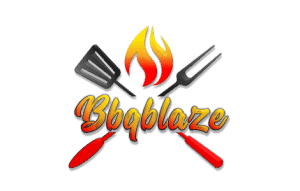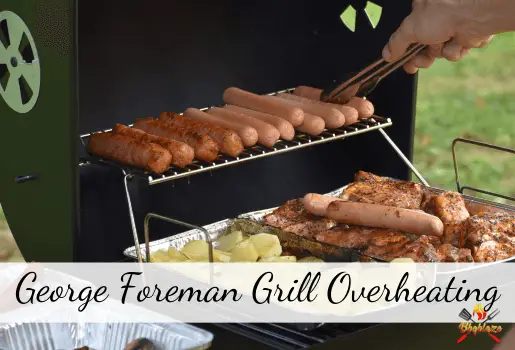As you use your George Foreman grill for friendly and family cooking sessions, adequate temperatures are important.
The most commonly used Foreman grills boast a green and red light.
The red light signifies that the grill is in preheating mode.
The green light signifies that your grill is ready for use and you can proceed to load it with meats, veggies, and more.
In cases of the George Foreman grill overheating several issues may be responsible.
Mostly, the grill may need simple temperature adjustments, while in other instances the thermostat may be faulty.
Whatever is causing the overheating scenario, it is crucial to note this cause to facilitate safer solutions.
George Foreman Grill Overheating – Causes
Thermostat
If the thermostat is blown it means the grill cannot provide optimal temperatures.
Instead, any temperatures set become futile and the result will be burnt foods.
Also, the thermostat may be reading that temperatures are still relatively low.
In this case, it is important to have an external probe handy to further ascertain that temperatures are indeed optimal.
Settings
Some newer George Foreman grills such as the Evolve model allow you to preset searing temperatures.
If these settings are too high or entered repeatedly, they could lead to overheating.
Although the grill will bring temperatures down to 400 degrees, the user is also responsible for limiting the attempts to raise temperatures.
Power supply
Excess power past the maximum load could lead to overheating.
This excess heat could begin with the wiring and end up with extremely hot plates.
Ensure that power outlets and power supply is always at recommended levels.
This includes understanding the ratings in your region.
For example, a George Foreman grill overheating in parts of the EU could be due to too much voltage; i.e. over 120 volts.
All the above could be causes of your George Foreman Grill overheating and ruining any food on the plates.
It is thus important to follow the solutions below to avoid messing up a perfect set-up grilling afternoon.
George Foreman Grill Overheating – Solutions
Check Thermostat
Have an expert examine the thermostat for any faults.
This includes checking if the voltage fed to the thermostat is over the limit.
It may require the use of a multimeter to better understand how much electricity is flowing through the thermostat.
If it is faulty, an expert is better equipped to suggest legitimate places to source a new thermostat.
Buying used thermostats from broken grills won’t end well.
It is better to spend more on a new thermostat and enjoy the longer lifespan of your grill.
Learn settings
Adjust temperatures accordingly and intermittently.
It is dangerous to keep adding temperatures without giving the grill time to adjust.
Normally, one should let the grill sit for about five minutes after adjustments.
It means pressing the + button more than once within five minutes could lead to overheating.
Try pressing it once and test to see if temperatures have indeed increased according to desired hotness.
If settings and heat don’t seem to be in harmony, have a technician examine the appliance.
Power Supply
Check that your supply is adequate for the grill in question.
Many George Foreman grills were built for the American market.
It means they work well up to a maximum of 120 volts.
Any voltage readings above this will cause the device to overheat and possibly spoil.
There could also be a chance that your breakers are not working as they should, or the sockets are inadequate; which brings us to the next point.
Power outlets
Your sockets may be faulty and instead of a throughput of 100 volts they are allowing twice the amount.
Check that the power outlets are not faulty.
To check this safely, move the appliance to a different power outlet.
Try grilling something that needs a little less heat and wattage.
Perhaps grill veggies instead of meat to ensure the outlet is working fine.
If it is not, please seek consultation from a professional electrician.
Food temperature
Could it be that some food on the plates is colder than others?
When preparing meals, there is a chance of placing some frozen foods with food that has thawed.
In this case, it may seem like the grill is overheating when in fact it is working harder to cook frozen foods.
Keep this in mind when preparing meals.
Always place foods of the same temperatures together and at the same temperatures.
No Control Knob
Earlier models did not have temperature control knobs.
This meant that grill men would keep lifting the lid while checking to see if their food was under, well, or overcooked.
In this instance, the grill is likely to overheat.
The best solution would be a temperature probe alerting you when there is too much heat in the kitchen.
Also, one can try testing the temperature on the plates with small food like veggies before placing meat on them.
How to Reset a George Foreman Grill?
1.Unplug the grill especially if it boasts error codes; meaning it is one of the new models.
2. Allow the grill to idle for a few minutes then plug it back in.
3. Any error codes that may have appeared before should be cleared by now.
4. Proceed to use the grill like you normally would, checking to see if it performs optimally.
5. If the grill continues to pose issues, repeat steps one through four again.
6. Other newer models may have reset options built into their -/+ buttons, or the SEARING button.
The process of resetting your grill using these options is present in user manuals.
Ensure that you download the right manual for your exact model of George Foreman grill.
What is the Maximum Temperature For a George Foreman Grill?
The maximum temperature of George Foreman grill is varies by model, generally reaching up to 400°F, 425°F, or even 500°F.
The precise maximum temperature depends on the grill’s design and intended use.
These temperatures are appropriate for achieving efficient cooking results, particularly for grilling, searing, and cooking various types of food.
It’s important to refer the grill’s user manual for accurate temperature information, as different models can offer varying heat settings.
Following to the recommended maximum temperature ensures optimal cooking performance while preventing possible damage to the grill or risks of overheating.
Always follow safety guidelines such as appropriate cooking temperatures, monitoring the cooking process, and avoiding prolonged contact with hot surfaces.
How Long Does It Take for a George Foreman Grill to Cool Down?
A George Foreman grill takes around 10 to 15 minutes to cool down after being used.
The cooling time may differ depending on factors such as the specific model of the grill, the cooking temperature used, and the duration of use.
The grill’s heating elements and cooking plates hold heat, and the cooling process allows them to gradually dissipate that heat.
To ensure safety during the cooling time, it’s recommended to unplug the grill from the power source and avoid touching the hot surfaces.
Waiting for the suggested cooling time before cleaning or storing the grill helps prevent accidental burns.
Bottom Line
Enjoying money well spent on a George Foreman Grill depends mostly on good maintenance.
This includes checking the calibration of thermostats and gauges along with regular cleaning.
An extremely dirt grill could lead to overheating too.
This is because your grill may detect more ‘food’ than there is; Happy grilling with the George Foreman grill.

